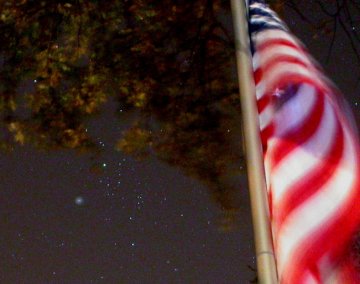 Where's Saturn? Is that a UFO--or the ISS? What's the name of that star? Get the answers from mySKY--a fun new astronomy helper from Meade. Where's Saturn? Is that a UFO--or the ISS? What's the name of that star? Get the answers from mySKY--a fun new astronomy helper from Meade. SPACE WEATHER OVER AFRICA: Scientists are converging on Ethiopia this week to discuss a new and strange form of space weather over Africa. Get the full story from Science@NASA. CORONAL HOLE: Japan's Hinode spacecraft is monitoring a large dark hole in the sun's atmosphere--a coronal hole: 
Coronal holes are vast regions where the sun's magnetic field opens up and and allows solar wind to escape. A solar wind stream issuing from this hole is blowing against Earth now and it could spark a geomagnetic storm. (NOAA forecasters estimate a 10% chance of a severe high-latitude storm during the next 24 hours.) Northern sky watchers should be alert for auroras. COMET 17P/HOLMES: Twenty-seven seconds. That's all the time you need to capture a nice picture of Comet 17P/Holmes. Last Friday night, Tom Wagner of Waterloo, Iowa, pointed his Nikon Coolpix 4500 at Perseus, opened the shutter for 27 seconds at ISO 400 and--voila!--an exploding comet: 
"I am amazed at how bright Comet Holmes is," he says. "I've driven around town showing my relatives and students this awesome sight." Comet 17P/Holmes is definitely worth watching. On Oct. 24th the comet exploded, brightening a million-fold to naked eye visibility. It has since expanded almost as large as a full Moon while dimming only slightly. And on Nov. 8th, astronomers watched in amazement as the comet's tail broke off! Got a telescope? Monitoring is encouraged: sky map, ephemeris. 3D BONUS: Grab your 3D glasses. Graphic artist Patrick Vantuyne has combined two photos of Comet Holmes, one taken by Jack Newton in Arizona and one by Ivan Eder in Hungary, to create an eye-popping stereo portrait: stereo image. "The stereo effect has nothing to do with the different locations of the photographers," he notes. "It is a result of the movement of the comet among between the two pictures." Comet 17P/Holmes Photo Gallery
[Interactive World Map of Comet Photos]
[sky map] [ephemeris] [3D orbit] [Night Sky Cameras]
| 
